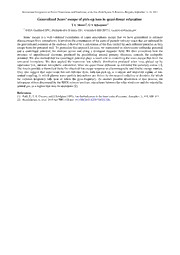
NASA Technical Reports Server (NTRS) 20110011732: Generalized Jeans' Escape of Pick-Up Ions in Quasi-Linear Relaxation PDF
Preview NASA Technical Reports Server (NTRS) 20110011732: Generalized Jeans' Escape of Pick-Up Ions in Quasi-Linear Relaxation
International Symposium on Recent Observations and Simulations of the Sun–Earth System II, Borovets, Bulgaria, September 11–16, 2011 Generalized Jeans’ escape of pick-up ions in quasi-linear relaxation T E Moore1, G V Khazanov1 1 NASA Goddard SFC, Heliophysics Science Div. Greenbelt MD 20771, [email protected] Jeans’ escape is a well-validated formulation of upper atmospheric escape that we have generalized to estimate plasma escape from ionospheres. It involves the computation of the parts of particle velocity space that are unbound by the gravitational potential at the exobase, followed by a calculation of the flux carried by such unbound particles as they escape from the potential well. To generalize this approach for ions, we superposed an electrostatic ambipolar potential and a centrifugal potential, for motions across and along a divergent magnetic field. We then considered how the presence of superthermal electrons, produced by precipitating auroral primary electrons, controls the ambipolar potential. We also showed that the centrifugal potential plays a small role in controlling the mass escape flux from the terrestrial ionosphere. We then applied the transverse ion velocity distribution produced when ions, picked up by supersonic (i.e., auroral) ionospheric convection, relax via quasi-linear diffusion, as estimated for cometary comas [1]. The results provide a theoretical basis for observed ion escape response to electromagnetic and kinetic energy sources. They also suggest that super-sonic but sub-Alfvénic flow, with ion pick-up, is a unique and important regime of ion- neutral coupling, in which plasma wave-particle interactions are driven by ion-neutral collisions at densities for which the collision frequency falls near or below the gyro-frequency. As another possible illustration of this process, the heliopause ribbon discovered by the IBEX mission involves interactions between the solar wind ions and the interstellar neutral gas, in a regime that may be analogous [2]. References [1] Puhl, P., T. E. Cravens, and J. Lindgren (1993), Ion thermalization in the inner coma of a comet, Astrophys. J., 418, 899–911. [2] Heerikhuisen, J., et al. 2010 ApJ 708 L126 doi: 10.1088/2041-8205/708/2/L126,
